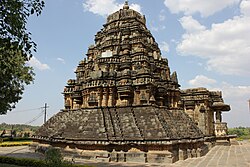Galaganatha
| Galaganatha ಗಳಗನಾಥ |
||
|---|---|---|
|
|
||
| State : |
|
|
| State : | Karnataka | |
| District : | Haveri | |
| Sub-district : | Haveri | |
| Location : | 14 ° 55 ' N , 75 ° 41' E | |
| Height : | 520 m | |
| Area : | 6.61 km² | |
| Residents : | 1,174 (2011) | |
| Population density : | 178 inhabitants / km² | |
| Galaganatha - Galageshvara Temple | ||
Galaganatha or Galaganath ( Kannada : ಗಳಗನಾಥ) is a village with about 1,200 inhabitants in the Indian state of Karnataka . It is known for having a medieval Hindu temple .
Location and climate
Galaganatha is located on the Tungabhadra River in north-central Karnataka about 40 km (driving distance) northeast of Haveri and 75 km south of Gadag at an altitude of around 520 m on the Dekkan Plateau. The climate is subtropical and warm; Rain (approx. 770 mm / year) almost only falls in the summer monsoon months .
population
Approx. Ninety percent of the majority Kannada- speaking population are Hindus and about 9% are Muslims ; other religious groups hardly play a role among the rural population of India. The male and female proportions of the population are roughly balanced.
economy
The village of Galaganatha is still oriented towards agriculture, whereby the self-sufficiency economy that had existed for centuries was more and more replaced by market economy elements with the emergence of better transport conditions in the second half of the 20th century.
history
In the Middle Ages, the place and temple belonged to the sphere of influence of the western Chalukya dynasty; In the 14th century, the Vijayanagar empire took power, which was defeated by the united Dekkan sultanates in the battle of Talikota (1565). From the beginning of the 19th century, the British also controlled southern India.
Attractions

- The only attraction of the village, which was originally called Palluni , is the Galageshwara temple from the Chalukya period of the late 11th century , consecrated to the Hindu god Shiva . The building at ground level consists of three parts: a richly articulated but figure-less cella ( garbhagriha ) with stepped sloping in the lower part with tower structure ( vimana ) and "umbrella dome", a small anteroom ( antarala or sukhanasi ) as well as a cross-bearing and on three sides open vestibule ( mandapa ) with wide balcony openings. The flat roof of the vestibule rests on turned soapstone columns ; the ceiling compartments inside show little decoration. The actual cella with its black lingam stone is separated from the vestibule by two stone grids ( jali ); In front of the portal is the Nandi bull, which is mandatory for Shiva temples .
- Two medieval inscription steles and the torso of a figure are placed in the entrance to the vestibule of the temple. One of the inscriptions dates from 1080 and is understood as an indication of the (early) time the temple was built.
Web links
- Galaganatha, Temple - Photo + Info (English)

